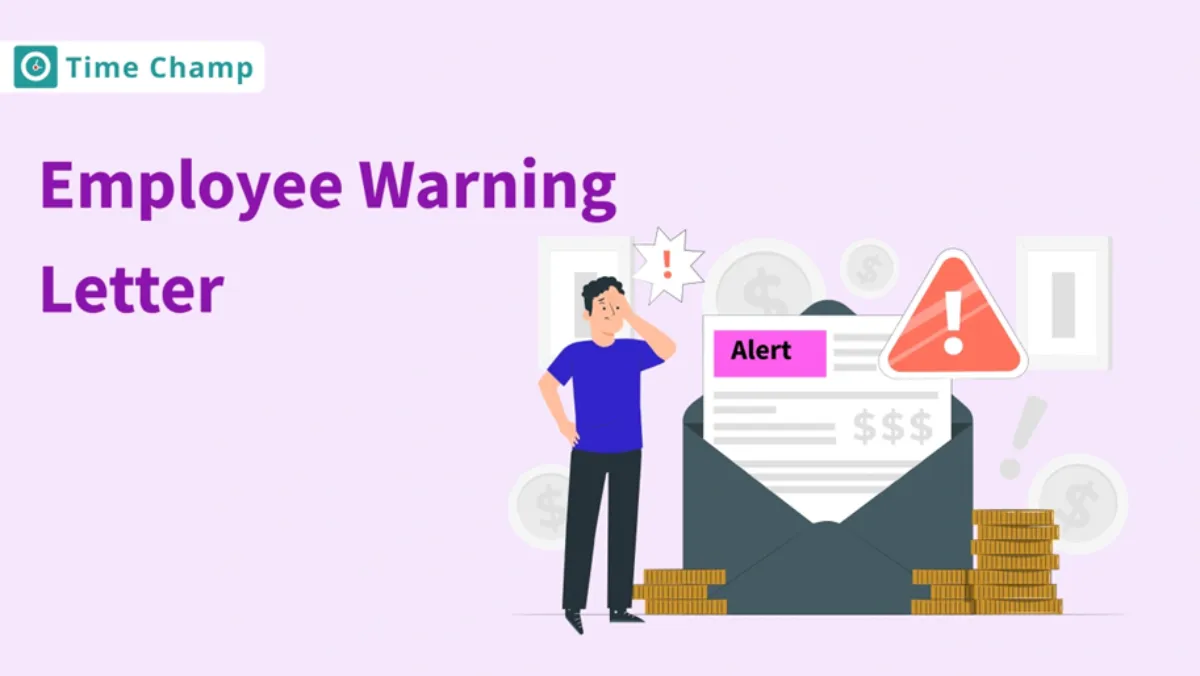Writing an employee warning letter is an important part of managing a team. It’s a formal way to tell an employee about a problem with their work or behavior and give them a chance to improve.
But writing one is indeed a difficult task; you need to convey the issue without sounding rude and then somehow still show your disappointment towards the employee’s actions.
In this guide, we’ll show you what a warning letter for employees is, what to include in a warning letter, and how to write one along with some sample templates to help you create a clear and professional letter.
What is an Employee Warning Letter?
An employee warning letter is a written formal notice sent to an employee for misconduct, breaking policy or failing to perform well. It specifically states the problem, anticipated improvement, and potential consequences if the action continues. Aside from documentation, it's important for establishing expectations, reinforcing responsibility. Properly issued warning letters help to legally protect the organisation while also establishing a polite, professional, and productive work environment.
When To Issue a Warning Letter
Send a warning letter when employees do not respond to earlier verbal or unofficial reminders. Some common reasons are misconduct, not performing well, breaking company policies, missing work, and leaving without informing anyone. Document earlier warnings before you send a formal letter.
Legal Considerations
Warning letters to employees must follow labour laws and company policies to prevent problems. Speak neutrally, maintain accurate records, treat everyone the same and respect employees’ privacy. Good documentation is necessary to protect yourself from unfair dismissal claims.
Progressive Discipline Process
If someone fails to improve, the process proceeds from verbal warning to written warning to another written warning letter and may result in termination. By following this process, employers can be sure they receive fairness and that the law is followed.
How to Write an Employee Warning Letter?
Whenever employee actions or performance become an issue, it is essential to document the situation formally. A well-structured warning letter makes it easy to explain issues and outline expectations. Follow these tips to guarantee that your letter is fair, accurate and abides by the law.
Include Basic Information
Begin the letter by explicitly writing down the employee's full name, job position, department, and date of composition. It allows you to address the person directly and document all the details for further records. Writing down this basic information also avoids confusion on the part of whom the letter is intended for.
State the Purpose of the Letter
Clearly state that this is an official warning about a specific issue. Be direct and professional, informing the employee that this is an official letter meant to deal with issues that have already been verbally discussed before.
Describe the Incident or Issue
Give a clear description of the performance or behavior issue. Use specific dates, times, and examples to prevent ambiguity. If the problem is about poor performance, state missed deadlines or quality issues. If misconduct, write down the acts that broke company policy. Use only facts and avoid using emotional tones.
Reference Company Policies or Expectations
Connect the performance or behavioral problem to the company policy, employee handbook, or job description. This allows the worker to know specifically which standards or rules were not complied with. Referring to these policies justifies the notice and makes expectations clearer.
Explain the Impact
Show how the employee’s actions affect the team, their department, or the entire company. For example, a company might face reduced output, an unpleasant workplace, risks to its workers, or damage to its brand name. Presenting the impact of what they do helps the employee see the importance of making a change.
Set Clear Expectations and Timeline
Specify which improvements or changes the employee needs to make. Make your goals easy to check and stick to, such as "Be sure to arrive on time for every shift for the next 30 days." Also, make sure you set improvement goals and a deadline that is possible for the employee to reach.
Include Consequences and Signature Section
Notify the employee about the possible repercussions if the offending behaviour is not improved, i.e., additional disciplinary action or potential termination. It emphasizes the difficulties caused by issues and indicates that immediate action is required. Lastly, leave room for both the employee's and supervisor's signatures and for reading the letter. This record is useful for legal and HR reasons.
Common Pitfalls to Avoid in Warning Letters
A warning letter should be written clearly, consistently and in a professional manner. Making sure you avoid typical mistakes can help guarantee your letter is fair, effective and legal.
Being Vague or Ambiguous
Many times, warning letters are not clear, so employees have trouble understanding why they are being warned. Rather than writing “Your work is not good enough” or “You broke company rules,” the letter should specify the details and the company rule that was not followed. Well-organized and clear documentation guarantees transparency and clear records. Rules must be easy to follow, both for employees and for HR records.
Best Practice: A good approach is to use details like “The weekly sales reports were not submitted for 3 consecutive weeks in March.”
Using Overly Harsh or Emotional Language:
Although warning letters should express concern, they should always be polite and neither threatening nor angry. Statements such as “you’ve lost your job” and “this is not tolerable” can hurt your team’s spirit and potentially lead to legal problems with complaints about hostility at work. Always write in a calm way that shows fairness and professionalism.
Best Practice: Make your feedback specific by saying things like, “Your tasks have not met the expectations of your job description."
Failing to Document Previous Incidents:
The problem shouldn’t be a surprise to the employee when a warning letter arrives, especially when it happens regularly. Many firms start with verbal warnings and then move on to writing down the problem if it arises. If you haven’t recorded your earlier talks or coaching sessions, the letter of concern could seem unwarranted. Because of this gap, an employer’s defence can be weaker in any formal hearing or disciplinary situation.
Best Practice: Don’t forget to mention the dates of previous discussions and the results and add copies of achievement forms and past warnings if needed.
Not Following Company Policy
All warning letters should be consistent with the organization’s disciplinary rules mentioned in the employee handbook. A refusal to issue a verbal warning before penalties or not reporting the incident to HR professionals may result in lawsuits. When disciplinary actions are not equally applied, others may accuse the organization of being unfair or biased.
Best Practice: Make sure to read the company’s HR policies first and ensure that you treat all employees in the same way with formal warnings.
Sample Warning Letter Templates
Warning Letter for Misconduct and Unprofessional Behaviour
Date: [Insert Date]
Employer’s Full Name: [Insert Name]
Office Address: [Insert Address]
Subject: Warning Letter for Misconduct
Dear [Employee’s Name],
I am writing to formally notify you that your recent behavior on [date of the incident] constitutes misconduct and is in violation of our company policies.
To ensure clarity on expected conduct, please review the company’s Code of Conduct and related policies. We value every team member’s contribution and are committed to maintaining a positive, respectful, and professional work environment.
This letter serves as an official warning. Continued misconduct may lead to further disciplinary action, including termination of your employment.
Please take this matter seriously and adhere strictly to company policies moving forward.
Best regards,
[Your Name]
[Your Position]
[Signature]
Warning Letter for Poor Performance
Date: [Insert Date]
Employer’s Full Name: [Insert Name]
Office Address: [Insert Address]
Subject: Warning Letter for Poor Performance
Dear [Employee’s Name],
This letter is to formally notify you that your recent work performance has not met the expectations outlined in your job description and company standards.
Specifically, on [mention dates or period], your performance has shown [describe issues briefly, e.g., missed deadlines, substandard quality, lack of productivity]. Despite prior discussions and support, there has been insufficient improvement.
We encourage you to review your responsibilities and make immediate efforts to improve. You may also reach out to your supervisor or HR for guidance or support.
Please understand that failure to improve your performance within [specify time frame, e.g., 30 days] may result in further disciplinary action, up to and including termination of your employment.
We believe in your potential to improve and look forward to seeing positive changes.
Best regards,
[Your Name]
[Your Position]
[Signature]
Warning Letter for Attendance and Punctuality Issues
Date: [Insert Date]
Employer’s Full Name: [Insert Name]
Office Address: [Insert Address]
Subject: Warning Letter for Attendance and Punctuality Issues
Dear [Employee’s Name],
This letter is to formally address concerns regarding your attendance and punctuality. It has been observed that you have been frequently absent or late without proper approval on the following dates: [list specific dates or time period].
Regular attendance and punctuality are essential for maintaining a productive work environment and meeting team goals. Continued absences and tardiness disrupt operations and affect overall performance.
Please consider this letter as an official warning. You are expected to improve your attendance and arrive at work on time moving forward. Failure to do so may result in further disciplinary action, including termination.
If there are any underlying issues affecting your attendance, please communicate them with your supervisor or HR as soon as possible.
Thank you for your immediate attention to this matter.
Best regards,
[Your Name]
[Your Position]
[Signature]
Warning Letter for Leave without Approval or Notice
Date: [Insert Date]
Employer’s Full Name: [Insert Name]
Office Address: [Insert Address]
Subject: Warning Letter for Leave Without Approval or Notice
Dear [Employee’s Name],
This letter serves as a formal warning regarding your recent unauthorized absence from work on [insert date(s)]. You failed to obtain prior approval or provide notice for your leave, which violates our company’s attendance policy.
Timely communication and approval of leave requests are crucial to ensure smooth operations and proper workload management. Your absence without notice has disrupted team productivity and affected business processes.
Please treat this letter as an official warning. Future instances of unauthorized leave may lead to further disciplinary action, up to and including termination of your employment.
If you are facing any issues that affect your ability to inform us in advance, please contact your supervisor or HR immediately.
We expect your full cooperation moving forward.
Best regards,
[Your Name]
[Your Position]
[Signature]
Final Warning Letter before Termination
Date: [Insert Date]
Employer’s Full Name: [Insert Name]
Office Address: [Insert Address]
Subject: Final Warning Letter
Dear [Employee’s Name],
This letter serves as a final warning regarding your continued [specify issue: poor performance, misconduct, attendance problems, etc.]. Despite previous warnings and efforts to help you improve, there has been insufficient progress.
Your recent [describe specific incidents or behaviors] on [mention dates] are not in line with company expectations and policies. This behavior affects the team and overall company operations.
Please consider this letter your last opportunity to correct the situation. Failure to show immediate and sustained improvement may result in termination of your employment.
We encourage you to take this seriously and make the necessary changes. Should you need support or clarification, please contact your supervisor or HR.
Thank you for your prompt attention to this matter.
Best regards,
[Your Name]
[Your Position]
[Signature]
Conclusion
Having the ability to write employee warning letters is necessary to handle behaviour at work and help the organisation grow. No matter if the issue is misconduct, missing work or underperforming, a properly written warning letter gives details, lays out rules and helps safeguard the rights and responsibilities of both employee and the company.
Using the company’s procedures, referring to related policies and keeping their communications professional and impartial helps HR professionals and managers handle issues with justice and clarity.
Keeping good documentation is important, as it protects the business and assists your team to function together consistently.
With the use of the sample templates and simple instructions, HR managers, team leaders, and executives can securely issue employee warning letters that result in better behaviour, enhance performance, and a better organizational culture.
Frequently Asked Questions
Though not always legally mandated, it is good practice to issue an oral warning initially as part of a graduated discipline process. It is an act of fairness and provides an opportunity for the employee to change his or her ways before formal discipline.
A warning letter should include name of the employee and their position, date of issue, full description of the issue which company policies were broken, effect of the problem, suggested steps for improvement, timeframe for improvements, consequences if behaviour continues and a place for the employee to sign for confirmation.
Firms usually file a warning letter in an employee’s file either for good or for a set period (commonly 6-12 months), following the company policy. When the employee continues to improve, they may be removed from the account, or they may be removed at their request if they are justified.
A warning letter should be professional, objective, and constructive. Avoid emotional or threatening language. The focus should be on correcting the issue and offering the employee a fair opportunity to improve.
Here are Some Related Articles You may Find Interesting

What is the Average Salary in Bangladesh: Overview & Insights
Discover The Average Salary in Bangladesh and outsourcing impact. Learn why it’s a rising player in global outsourcing.

Average Salary in India: Factors and Comprehensive Comparison
Discover the key factors influencing the average salary in India across industries, regions, and job levels, as well as insights.

What is the Average Salary in Colombia? & Factors Affecting
Discover the average salary in Colombia and explore the key factors affecting earnings, including industries, experience, and location. Find out.

What is the Average Salary in Indonesia?
Discover the average salary in South Africa and explore outsourcing trends. Learn key insights into wages, industries, and business opportunities.

What is the Average Salary in Hong Kong? and It’s Statistics
Learn about the average salary in Hong Kong, from minimum wage to maximum salaries, and gain insights into industry variations.

What is the Average Salary in Singapore: Economic Outlook
Discover the average salary in Singapore, key factors affecting income, insights into the nation’s economic outlook & explore its trends.




